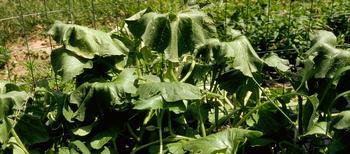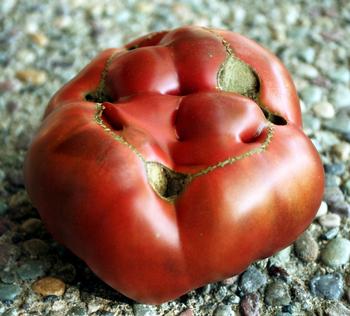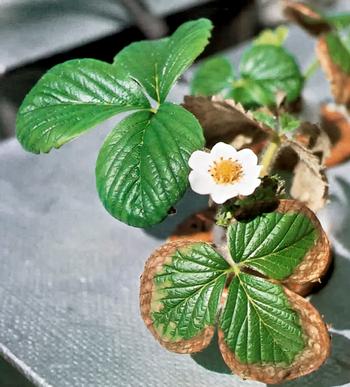What’s wrong with my plant?
-
Nanette Londeree
-
A citrus tree with yellowing leaves. Cat-faced tomatoes. A houseplant with wilted foliage. Almond-colored spots on the lawn. What do these things have in common? They’re plant problems caused by environmental conditions rather than some pest or disease. A frosty blast of arctic weather in early spring or hot, desert-dry summer winds, dull lawn mower blades, too much water, or not enough iron are just a few things that can produce symptoms in plants that make them look sick. The good news is that plenty of them are preventable.
 Wilted foliage can be a symptom of too much or not enough water. Photo: University of Maryland Extension
Wilted foliage can be a symptom of too much or not enough water. Photo: University of Maryland ExtensionPlant health problems are caused either by living things like insects, mammal pests, disease-causing microbes, or non-living actions or conditions - the environment, physical or mechanical damage, chemicals, and cultural practices. The nonliving causes, called abiotic disorders, are very common and often overlooked as the source of plant problems because they can be tricky to identify.
Common causes of abiotic disorders include:
Air temperature extremes - high temperatures increase a plant’s rate of transpiration resulting in wilting or injury to plant tissue, while very low temperatures cause the moisture in plant cells to freeze, burst, blacken and die as temperatures rise. Extreme fluctuations in day and night temperatures can result in cat-faced tomatoes. Photo: Nanette Londeree
Extreme fluctuations in day and night temperatures can result in cat-faced tomatoes. Photo: Nanette LondereeWater: Without adequate water, foliage can fade in color and wilt, turn brown, die along leaf margins and tips, and drop prematurely. Too much water, from over-irrigation or inadequate drainage, deprives roots of oxygen and they can suffocate.
Mechanical damage: Plants can be torn, cut, crushed, chewed, sliced, or punctured by wind, animals, lawnmowers and weed whackers, the errant gardener, or countless other possibilities.
Nutrient deficiencies and excesses: If essential nutrients, like nitrogen and iron, aren’t available to a plant, leaves may turn yellow and eventually drop. Too much of a particular nutrient or mineral can damage plant tissue like those tell-tale golden spots from dogs urinating on the grass (too much nitrogen).
Pesticide damage: Exposure to fungicides, insecticides, and plant growth regulators (types of herbicides), especially if temperatures are above 90∞F, can result in leaves that are burned, discolored, distorted, spotted, or drop prematurely. Foliage that has been exposed to herbicides can appear cupped, curled, chlorotic, produce small leaves, or result in the death of the entire plant.
Damage from abiotic causes often occurs suddenly, such as plant injury from a chemical or weather damage, often follows a uniform or repeated pattern on an individual plant or throughout a planting, like damage on a single side of a plant, and is non-specific, affecting multiple plant species, including weeds.
In some situations, there may be multiple factors, abiotic and biotic, contributing to a plant health problem. A mature pine tree stressed by ongoing drought conditions (abiotic) may be susceptible to attack by the bark beetles (biotic) that will ultimately kill the tree. Or mushrooms at the base of the tree may be the result of damage to the trunk of the tree by a lawnmower (abiotic) that allowed entry of a disease-producing fungus into the tree (biotic). Toxic levels of salt caused the margins on the strawberry leaves to turn brown and dry. Photo: UC Regents
Toxic levels of salt caused the margins on the strawberry leaves to turn brown and dry. Photo: UC RegentsPrevention is the key to most abiotic disorders. While you can’t control temperatures or rainy weather, there are plenty of things you can do. Start with healthy soil that drains well, and supplement with organic amendments to keep it vibrant. Select plants appropriate to the planting location. Provide plants with the water they need at the time they need it; check irrigation equipment regularly and maintain them in good working order. Protect plants, where possible, from temperature extremes and wind, and provide appropriate staking and support. Shield them from potential mechanical damage from lawnmowers, weed hackers, and shovels, and keep tools in good shape.
About those cat-faced tomatoes. Mother Nature was responsible for temperature swings from too cool to really hot that likely caused them, but the rest? The gardener! Dull mower blades, thatch build-up, or compaction are possible culprits for the spotted lawn, overwatering produced the wilting of the houseplant, and the citrus tree was growing in soil without enough iron.



